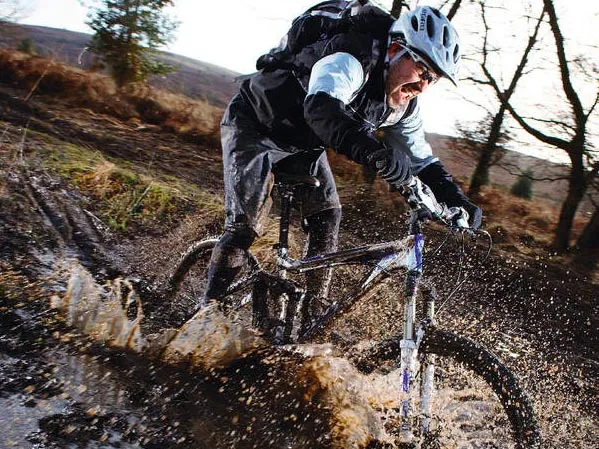If you can master riding in the mud then you can get so much more from your wet weather biking. Here’s how to get body, bike and brain working together to flow through muddy trails with speed and style.
From a thin sheen of slime on hardpacked dirt to thick gloop on claggy climbs, you’ll likely encounter some form of mud out on your bike, whatever the time of year.
How to maintain forward flow
The simple act of propelling your bike forwards gets much more complicated when the trail turns to mud. Suddenly you have the twin challenges of:
- Keeping the bike going forward
- Staying upright
First select a good line, and it’s usually obvious – look for the most solid part of the trail and head for that. Sometimes it can be underwater, as often the solid track under a puddle can be much easier to ride than the wet, sloping sides. Sometimes it’s a patch of gravel or rock – even just a small amount – on an otherwise slimy trail, so use every feature to give your traction a boost.
Next focus on pedalling smoothly – this is vital in mud. You need to use a gear that lets you spin the pedals at about 70-80 rpm, making sure you apply the power as evenly as possible right through the pedal stroke. If you don’t, and go for the big push at the front of each stroke, you’ll just make the back wheel break traction and spin. Then as you go through the middle of the pedal stroke, the bike will stall where there’s little power.
How to select a clever cadence
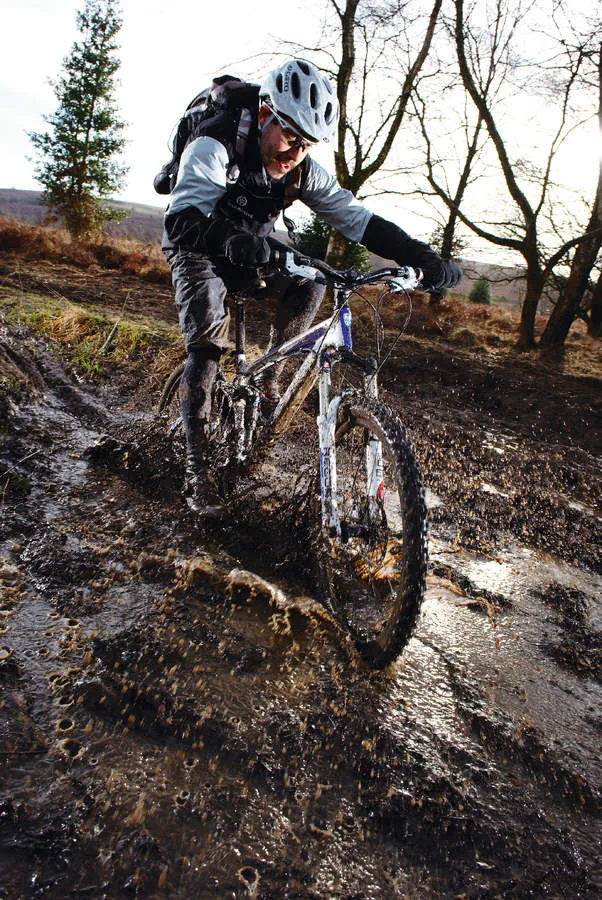
A cadence higher than 80rpm can work for mountain biking but it’s not seen that often, unless someone also does a lot of road biking.
Generally it’s best to leave yourself able to accelerate suddenly without changing gear – for a quick wheelie or to burst through a really deep or slippery section. You can do this by suddenly going from 80 to 110rpm, but if you’re already spinning at 110 you haven’t got much acceleration left without a gear change.
Weight distribution and body position affects grip but also your ability to stay upright as you pedal.
This is one of the finest balancing acts in mountain biking – you need to keep all your joints flexible and sensitive to changes in terrain, because you’ll have to adapt constantly. The key points to remember are:
- Weight hard on the saddle gives you maximum back wheel grip for pedalling
- Weight over the front gives maximum front wheel grip for direction control
- Standing allows body weight to be transmitted through the bottom bracket, increasing stability
If you think about these three, it’s near impossibe to do them all at the same time, so you have to adapt to the trail. On mud, the bike can suddenly shift sideways in many situations.
If we’re standing or stand quickly as it moves, the bike stays upright. It doesn’t have to be a big shift, you can just hover over the saddle, but the difficulty is continuing to pedal smoothly in this position.
If we’re seated then our body weight – acting through the giant lever of the seat post – gives us good grip and drive, but if the bike slides then it can quickly bring us crashing to the ground. The trick is to be able to switch between these positions as the trail demands.
How to get through mud fast

Racing through mud is something we Brits are masters at. If you look at the greats like Frischi then you’ll notice that a muddy course in a World Cup saw him overtaking scores of opponents, especially in off-camber sections.
So what’s the secret to high-speed mud riding? It’s all about proprioception. This is sometimes described as the sixth sense – it’s the way your body relates to the space around it and reacts instantly and unconsciously to changes it picks up through sensory receptors inside your body.
When we learn any new movement-based skill then we have to develop this sense to ensure that our reactions are correct.
1. So the first step is to slow right down and develop your sense of instant body control by working on your trackstands – balancing on your bike with the brakes off, feet level, standing up and at a standstill. This teaches you to make small, instant adjustments in your body position to stay upright, which is exactly what you must do when the bike slides.
2. Next you need to practise skids to improve your reactions as the bike slides.
3. Finally, get on to the trails and attack the mud with confidence. Stretch your vision as far ahead as you dare, keep weight centred and your body, arms, legs and hips loose and low as possible. When the bike slides, tell yourself to enjoy it and don’t tense up. Just relax and go with the flow!
How to get cranking through the corners

The world doesn’t change completely when it gets wet, it just gets more slippery. So corners on bike trails are just the same, and you still need to follow the same basic rules:
- Choose a good line on entry
- Drop the outside foot in the turn
- Look through the trail and focus on the exit, rather than looking down
But what changes is that you have less grip, so you need to work that bit harder to create it and to stay smooth so you can hold it.
You want the bike to tilt over quite hard, even if speeds are low, because it lets you turn the bars less – meaning less risk of digging the front wheel into the mud, or sliding it out sideways. This also gets the tyre side knobs biting hard into the trail, giving much-needed extra grip.
Next you need to push the bike into the ground to increase the grip. This pump action is the simple act of pushing your body weight down into the bike. Do this mostly through the dropped outside foot as you go through the apex of the turn. In slippery terrain you have to do this progressively, not as one sudden jerking movement.
How to return from the deep

When the mud gets deeper you need to find the bottom of the quagmire and bite the back tyre into it.
Do this by pumping down hard on the saddle with your backside, just as you crank the pedals. This bouncing technique can throw you forwards in short bursts, but good balance (remember to practise those trackstands!) is essential too.
Cut your steering back and keep the front wheel light. Any sudden movement on the bars could bed the front end deep into the mud, and stop you in your tracks.
But most important of all is your mental attitude. Hitting a patch of deep mud you weren’t expecting is a test of willpower – especially if you’re in SPD pedals. Strong determination, matched with good technique, balance and a gear that’s easy enough to keep turning, even when you’re nearly stalled, can get you through. Just put your wallet, camera and phone in a dry bag before you try!
Top tip – Hover and move
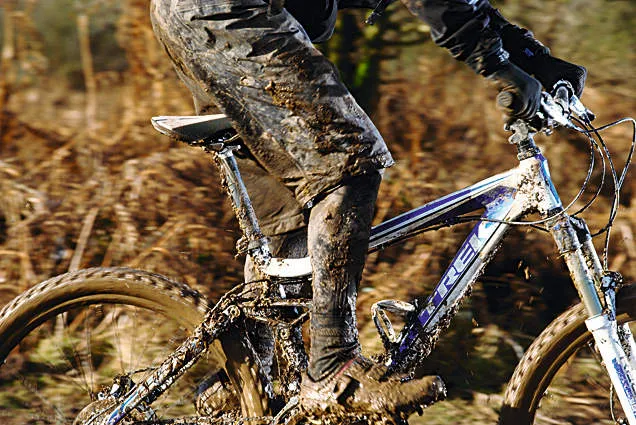
If you rise just above the saddle as you pedal along then you’re ready to do anything – throw weight forward for steering control, back or down onto the saddle for traction, or stay raised and loose to correct a slide. Fast reactions are everything when pedalling in unpredictable terrain.
Setup tips for mastering mud
Catching the crud
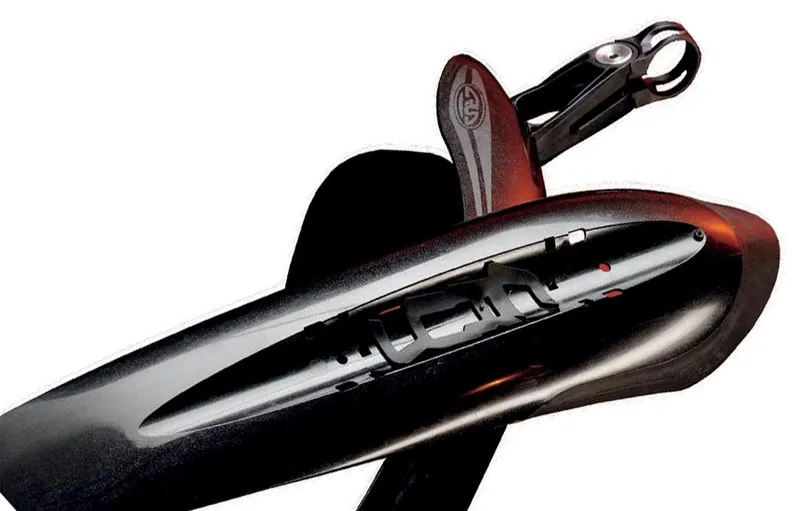
Keeping yourself, your bike and your clothing free of mud and water is a pretty cool idea. Not everyone wants a Crud Guard on the back of their bike – either they don’t like the style, or they think they’ll catch it as they go behind the saddle for steep terrain. But the feeling of wet backside, the soaking rucksacks, the brown arse-stripe… it’s all so easy to avoid with this cheap, plastic mud-stopping gadget – and if you’re a weight freak, they’re very light, too. If you do have to get so far back that you hit it with your crotch, you’ll be glad it was a crud guard you landed on, and not a fast, rotating tyre!
Burning rubber
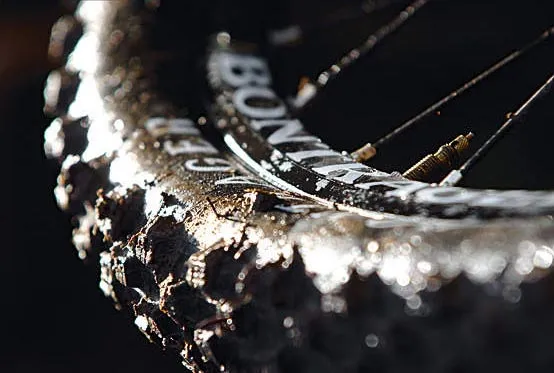
Tyre choice makes a huge difference to performance in the mud. There are many options and it’s important to consider the mix of terrain you’ll be using – and not just the mud – if you want to find the right one. Skinny options will cut through anything, and are ideal for muddy race courses, but when you hit rock, road or hardpack then you’ll have little corner control or grip.
Our current favourite is the MudX TR 2in tyre from Bontrager. The mid-length nobs give good grip but don’t squirm too much on rock or hardpack, letting you turn and grip on climbs.
Meet our coaching expert

Chris Ford founded his company, CycleActive, in 1996 and set out to create a professional training and travel operation.
He was the first to employ only qualified, professional instructors and now his team leads the way in delivering skills coaching. Recently Chris has been working closely with British cycling orgnisation the CTC on its mountain bike instruction programme.
Combined with his own research on mountain biking skills and instruction, his level 4 coach status as an SMBLA tutor, expedition and night riding instructor, this really sets him apart as a coach – making him the perfect author for these Technique pieces.
To find out about coaching or group courses with Chris and his team, visit www.cycleactive.co.uk.
